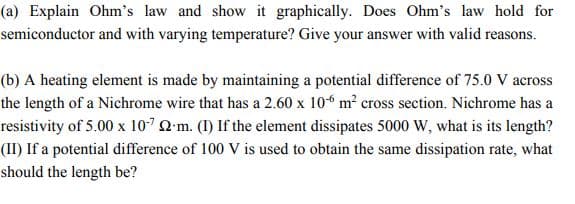(a) Explain Ohm's law and show it graphically. Does Ohm's law hold for semiconductor and with varying temperature? Give your answer with valid reasons. (b) A heating element is made by maintaining a potential difference of 75.0 V across the length of a Nichrome wire that has a 2.60 x 10“ m? cross section. Nichrome has a resistivity of 5.00 x 107 Q'm. (1) If the element dissipates 5000 W, what is its length? (II) If a potential difference of 100 V is used to obtain the same dissipation rate, what should the length be?
(a) Explain Ohm's law and show it graphically. Does Ohm's law hold for semiconductor and with varying temperature? Give your answer with valid reasons. (b) A heating element is made by maintaining a potential difference of 75.0 V across the length of a Nichrome wire that has a 2.60 x 10“ m? cross section. Nichrome has a resistivity of 5.00 x 107 Q'm. (1) If the element dissipates 5000 W, what is its length? (II) If a potential difference of 100 V is used to obtain the same dissipation rate, what should the length be?
Related questions
Question

Transcribed Image Text:(a) Explain Ohm's law and show it graphically. Does Ohm's law hold for
semiconductor and with varying temperature? Give your answer with valid reasons.
(b) A heating element is made by maintaining a potential difference of 75.0 V across
the length of a Nichrome wire that has a 2.60 x 10“ m? cross section. Nichrome has a
resistivity of 5.00 x 107 Q'm. (1) If the element dissipates 5000 W, what is its length?
(II) If a potential difference of 100 V is used to obtain the same dissipation rate, what
should the length be?
Expert Solution
This question has been solved!
Explore an expertly crafted, step-by-step solution for a thorough understanding of key concepts.
Step by step
Solved in 4 steps with 4 images
